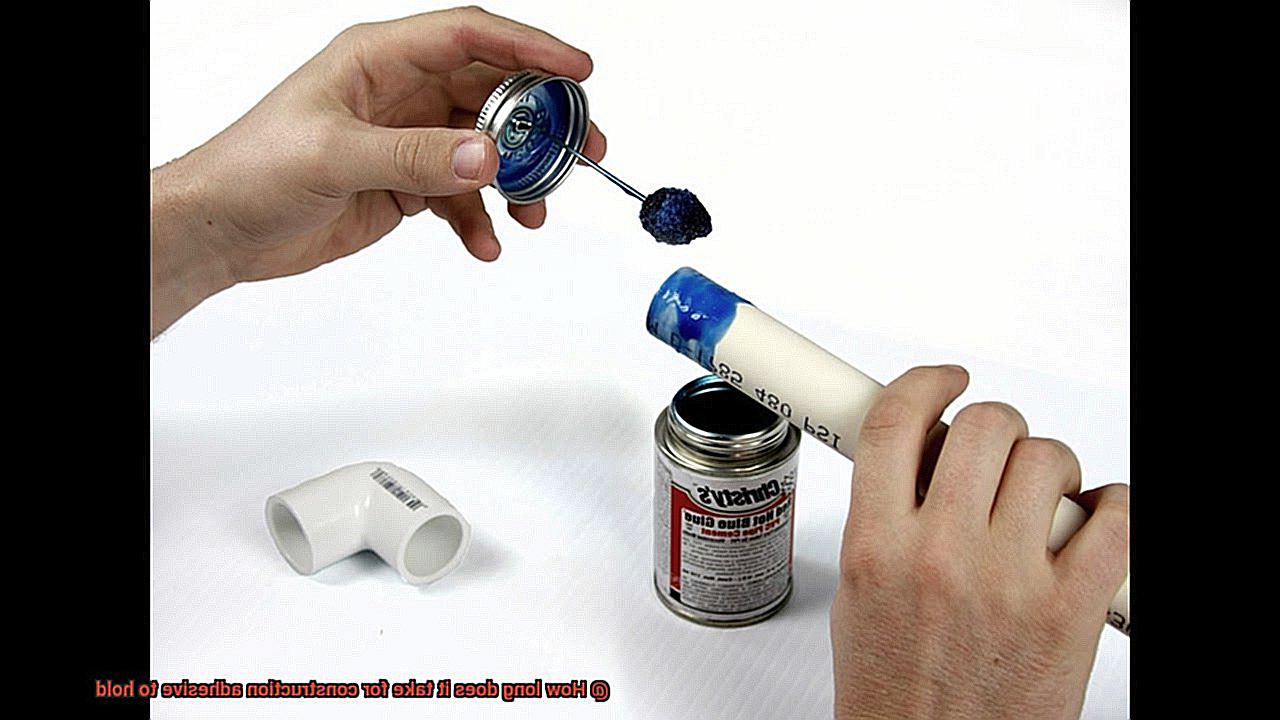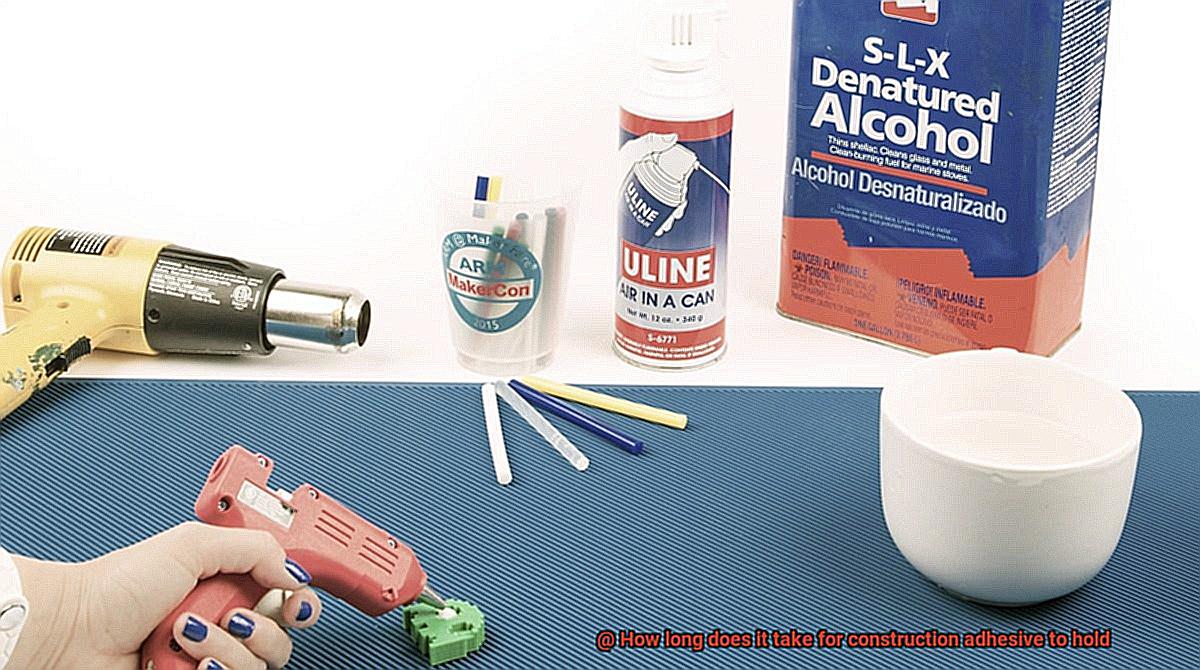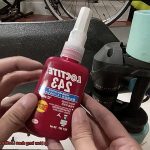Well, we’ve got some adhesive news that will make your construction endeavors a whole lot easier. Today, we’re diving into the holding power of construction adhesive and how long it takes to achieve that rock-solid bond.
From its initial stickiness to its full strength, we’ll uncover the secrets of this powerful adhesive. So, if you’re curious about how long it takes for construction adhesive to hold and want to get your projects done in no time, stick around (pun intended).
Grab your hard hat because we’re about to explore the adhesive world together.
What is Construction Adhesive?
Contents
- 1 What is Construction Adhesive?
- 2 How Long Does it Take for Construction Adhesive to Hold?
- 3 Factors Affecting the Curing Time of Construction Adhesives
- 4 Different Types of Construction Adhesives and Their Curing Times
- 5 Applying Pressure or Clamps During the Curing Process
- 6 Allowing Ample Time for the Adhesive to Fully Cure
- 7 General Guidelines for Curing Times of Construction Adhesives
- 8 Conclusion
Construction adhesive is the ultimate bonding solution for all your construction and home improvement projects. It is a versatile and durable adhesive that ensures your materials stay securely bonded together. Let’s delve into the features and uses of construction adhesive to gain a comprehensive understanding of this essential glue.
Construction adhesive is designed to bond a wide range of materials, including wood, metal, concrete, stone, ceramic, and plastics. This versatility makes it suitable for various applications in both construction and DIY projects.
One of the standout features of construction adhesive is its initial tack. This means that the adhesive holds the surfaces together immediately after application, allowing for quick and precise positioning of materials. It’s perfect for vertical applications where gravity could cause shifting or sliding.
Once fully cured, construction adhesive forms a strong and durable bond that can withstand significant stress and load-bearing forces. This makes it an ideal choice for bonding heavy materials or when mechanical fasteners are not suitable or desired.
Construction adhesive is resistant to water and moisture, making it suitable for both indoor and outdoor use. It also withstands extreme temperatures, ensuring the bond remains intact even in hot or cold conditions. This feature adds to its durability and reliability.
Furthermore, construction adhesive is generally flexible once cured, allowing for some movement or expansion and contraction of the bonded materials without compromising the bond. This flexibility ensures that your projects remain secure even in dynamic environments.
Now let’s explore some common uses of construction adhesive. It is widely used in woodworking projects for bonding wood pieces without the need for nails or screws. Additionally, it is an excellent choice for securing tiles to walls or floors due to its water-resistant properties. When repairing cracks or gaps in concrete surfaces, construction adhesive provides a reliable bond that withstands the rigors of weather and foot traffic. Moreover, it is often used in conjunction with screws or nails to secure drywall panels, providing additional strength and reducing the risk of sagging or shifting over time.
How Long Does it Take for Construction Adhesive to Hold?
When it comes to construction or DIY projects, the strength and durability of bonded materials are of utmost importance. That’s where construction adhesive swoops in to save the day. But have you ever wondered how long this adhesive superhero takes to work its magic? In this article, we’ll explore the factors that influence the curing time of construction adhesive and discover why patience is truly a virtue when it comes to bonding.
Types of Construction Adhesive:
Not all construction adhesives are created equal. Each type has its own specific curing time, ranging from a few hours to over 24 hours. It’s crucial to carefully follow the manufacturer’s instructions to determine the precise curing time for the adhesive you’re using. This step ensures that you achieve the desired bond strength and long-lasting durability.
Surfaces Matter:
The surfaces being bonded play a pivotal role in determining how long it takes for construction adhesive to hold. Porous materials like wood or concrete require more time for the adhesive to penetrate and create a robust bond. Therefore, it is essential to thoroughly clean, dry, and free the surfaces from any contaminants before applying the adhesive. By doing so, you optimize the bonding process and ensure a strong and enduring connection.
Environmental Conditions:
Just like humans, construction adhesive responds to its environment. Temperature and humidity can significantly affect the curing time. Higher temperatures accelerate the process, while lower temperatures slow it down. Moreover, high levels of humidity can prolong the curing time. When planning your project, it is vital to consider these environmental factors as they can greatly influence how long it takes for the adhesive to fully cure.
Patience is Key:
While construction adhesive may initially hold within a few hours, it continues to strengthen over time. Even after the recommended curing time has passed, it’s wise to avoid subjecting the bonded surfaces to excessive stress or loads until the adhesive has fully cured. So, resist the temptation to test the strength of the bond prematurely and exercise patience.
Factors Affecting the Curing Time of Construction Adhesives
If you’ve ever embarked on a DIY project involving construction adhesives, you know that waiting for the glue to cure can feel like watching paint dry. But fear not, crafters and builders, because today we’re delving deep into the factors that affect the curing time of construction adhesives. Get ready for some sticky science.

First and foremost, the type of adhesive you choose is crucial. Different adhesives have unique chemical compositions and curing mechanisms that directly impact their curing time. Some adhesives rely on a chemical reaction with moisture in the air to cure, while others require additional heat or pressure to activate their bonding magic.
But let’s not overlook the environment. Temperature and humidity levels can make or break your adhesive’s curing time. Higher temperatures and lower humidity levels speed up the process, while lower temperatures and higher humidity can put the brakes on curing. So, be sure to check the manufacturer’s recommendations for optimal conditions.
Now, let’s talk about the surface you’re bonding. Porous materials, like wood or concrete, have a knack for absorbing moisture from the adhesive, which can significantly affect curing time. On the flip side, non-porous materials such as metal or glass won’t absorb moisture, allowing for faster curing. Remember, cleanliness and smoothness of the surface also play a role in how well your adhesive bonds and cures.
Thickness matters too. Thick layers take longer to cure compared to thin ones. Why? Well, thicker layers may struggle to release trapped air or moisture, causing the curing process to drag on. So, apply your adhesive evenly and consistently for optimal results.
Did you know that how you apply the adhesive can impact its curing time? Applying it in dots or beads allows for better airflow and escape of trapped air or moisture, promoting faster curing. Pay attention to those tiny details.
Last but certainly not least, let’s talk about the adhesive formulation. Different manufacturers and even different product lines can have variations in formulation, resulting in different curing times. It’s crucial to read the instructions and recommendations provided by the manufacturer to ensure you’re using the right technique for the specific adhesive you’re working with.
By considering these factors, you can optimize the curing time of your construction adhesives, ensuring that your projects stand the test of time. Remember, patience is key when it comes to bonding, so embrace the wait and let your adhesive work its magic.
Different Types of Construction Adhesives and Their Curing Times
Have you ever wondered how glue can hold together big things like houses or bridges? Well, that’s thanks to a special kind of glue called construction adhesive. In this article, we’re going to dive deeper into the world of construction adhesives and explore the different types available, as well as their unique curing times. So grab your hard hat and let’s get started.
Solvent-Based Adhesives
If you’re in a hurry to finish your project, solvent-based adhesives are your best friend. These glues can hold materials together in just a few minutes or a couple of hours. Picture this: you’re working on a woodworking project, and you need those joints to hold tight as soon as possible. Solvent-based adhesives come to the rescue, forming a strong bond right from the start. No need to worry about things falling apart when you move on to the next step. These adhesives are quick and reliable, allowing you to keep building without waiting too long.
Water-Based Adhesives
Now, let’s talk about water-based adhesives. If you’re looking for an eco-friendly option, these are the way to go. They take a little longer to cure compared to solvent-based adhesives, usually several hours or even a few days. You might be thinking, “Why should I wait so long?” Well, here’s the thing – water-based adhesives need moisture to work their magic. They require time to dry properly and create a strong bond between materials. So, if you have the patience to wait for them to cure, you’ll be rewarded with an environmentally friendly adhesive that holds up beautifully in your construction projects.
Two-Part Epoxy
Now, let’s mix things up with two-part epoxy adhesives. Imagine combining two separate components and creating something super strong – that’s exactly what happens with these adhesives. They consist of a resin and a hardener that you mix together before using them. The curing time for two-part epoxy adhesives can vary depending on the specific product, but it typically ranges from a few hours to a day or more. Now, I know waiting can be tough, but trust me, it’s worth it. Two-part epoxy adhesives offer incredible bonding strength, making them ideal for heavy-duty applications where durability is key.
Applying Pressure or Clamps During the Curing Process
Today, we’re going to dive into the importance of applying pressure or using clamps during the curing process when working with construction adhesive. Whether you’re a DIY enthusiast or a professional contractor, understanding this crucial step will ensure your projects stand the test of time. So, grab your toolbox and let’s get started.
Achieving a Strong and Uniform Bond:
When it comes to construction adhesive, applying pressure is key. By doing so, we ensure that the adhesive spreads evenly between the surfaces being bonded. This creates a strong and uniform bond that can withstand the toughest challenges. The pressure helps to push the adhesive into any gaps or imperfections in the surfaces, maximizing contact and enhancing the bond strength.
The Role of Clamps:
Enter clamps, the unsung heroes of the curing process. Clamps are essential for holding materials together while the adhesive dries. They prevent any movement or separation during this critical stage, ensuring a secure and permanent bond. Clamps provide constant and consistent pressure across the entire bonding area, helping to eliminate air pockets and promote full adhesive coverage.
Timing Is Everything:
Different adhesives have varying curing times and clamping requirements. It’s vital to follow the manufacturer’s instructions to achieve optimal results. Some adhesives may only require a short period of clamping time, while others need several hours or even overnight. Patience is indeed a virtue. Rushing the curing process by removing clamps too soon can result in a weak bond that may fail over time.
Beware of Excessive Pressure:
While applying pressure is crucial, we must avoid going overboard. Excessive pressure or over-clamping can actually weaken the bond by forcing out excess adhesive, preventing proper contact and bonding. It’s important to find the sweet spot – enough pressure to secure the materials without causing squeeze-out. Squeeze-out occurs when too much adhesive is forced out from between the surfaces, leaving insufficient adhesive for bonding. This can result in a weaker bond and potential failure.
Alternatives to Clamps:
In situations where clamps aren’t feasible, fear not. You can still apply pressure during the curing process using alternative methods such as weights or heavy objects. Get creative and find what works best for your project. The key is to ensure that the weight or object applies even and consistent pressure across the entire bonding area.
Consider Environmental Factors:
Temperature and humidity play a significant role in the curing process. It’s essential to consider these factors, as they can affect both the adhesive’s drying time and overall bond strength. Consult the manufacturer’s guidelines to ensure you’re working within the optimal environmental conditions. Extreme temperatures or high humidity can interfere with the adhesive’s ability to cure properly, leading to weaker bonds.
Allowing Ample Time for the Adhesive to Fully Cure
Today, we’re plunging into the realm of construction adhesive and uncovering the significance of granting it the time it craves to fully cure. Whether you’re bonding wood, metal, plastic, or any other material, this is knowledge you can’t afford to overlook.
Let’s dive in, shall we? You’ve just completed the gluing process for that stunning bookshelf or repaired that broken chair, and you’re itching to put it to the ultimate test. But hold your horses. Speeding up the curing process of construction adhesive can lead to nothing but disaster.
Here’s why ample curing time is absolutely crucial: during the curing process, adhesive undergoes a chemical transformation that enhances its bond integrity. While it may appear dry to the touch within a few hours, that doesn’t mean it’s ready for action. Most construction adhesives demand a minimum of 24 hours to reach their peak strength and durability. However, colder temperatures or high humidity levels may prolong this timeframe.
To ensure your bond can withstand the test of time, consider these essential factors:
- Follow Manufacturer’s Instructions: Each adhesive comes with its own set of curing time recommendations. Don’t skip out on reading the fine print. Consult the manufacturer’s instructions or product datasheet for specific guidelines tailored to your adhesive.
- Optimal Conditions for Curing: Treat your adhesive like royalty during its curing process. Maintain a suitable temperature range as specified by the manufacturer and shield it from excessive moisture or extreme temperatures.
- Patience is Key: Refrain from applying any stress or load on the bonded materials until the adhesive has fully cured. Prematurely exposing your project to pressure may result in weak bonds that are destined to fail.
- Porous Materials Take Longer: Brace yourself for a lengthier curing time if you’re working with wood or other porous materials. These materials tend to absorb some of the adhesive, necessitating additional curing time for a sturdy bond.
- Enhance Bond Strength: Consider using clamps or applying pressure while the adhesive cures, as recommended by the manufacturer. This extra step can fortify the bond’s strength, reinforcing its longevity.
By allowing ample time for your construction adhesive to fully cure, you’re guaranteeing the endurance and tenacity of your project. Strong bonds are built on patience, my friends. So, resist the temptation to rush and give that adhesive the time it needs to reach its full potential.
Remember, following manufacturer’s instructions, providing optimal curing conditions, and avoiding premature stress or load are essential steps in achieving success with construction adhesive. Take these precautions, and you’ll be well on your way to creating projects that stand strong against any challenge that comes their way.
General Guidelines for Curing Times of Construction Adhesives
Don’t underestimate the importance of glue, my friends. It’s the glue that holds our projects together, quite literally.
Let’s start by exploring the different types of construction adhesives available. We’ve got epoxy adhesives, polyurethane adhesives, and acrylic adhesives. Each type has its own unique properties and curing characteristics.
If you’re looking for strength and durability, epoxy adhesives are your go-to. But here’s the catch – they take a bit longer to cure compared to other types. You’ll need to be patient and wait a few hours to several days for that bond to fully set. Trust me, it’s worth the wait.
Now, if you’re in a rush, polyurethane adhesives might be your best bet. They cure relatively faster, usually within 24 hours or less. But hold your horses. It takes a few days for them to reach their full strength. So don’t rush things too much, my eager friends.
But wait, there’s more. Acrylic adhesives are the speed demons of the bunch. They can cure in as fast as a few minutes to a couple of hours. Perfect if you’re on a tight schedule and need to finish your project quickly.
But it’s not just about the type of adhesive you’re using. Environmental conditions also play a significant role in the curing process. Temperature and humidity levels can make a huge difference. Higher temperatures speed things up, while lower temperatures slow them down. Similarly, high humidity levels can give your adhesive a boost.
To ensure success, always follow the manufacturer’s instructions regarding the recommended curing time. These guys know their stuff and have conducted extensive testing to determine the optimal timing for their products. Don’t underestimate their wisdom.
And here’s a pro tip: be patient. Rushing the curing process can lead to disastrous results. Give your adhesive the time it craves to fully cure before subjecting it to any stress or load. Clamping or providing additional support might be necessary, especially for heavy materials or load-bearing structures.
WSoaX4kgMeg” >
Conclusion
When it comes to construction adhesive, one burning question on everyone’s mind is: how long does it take for it to hold? Well, my friend, the answer may surprise you. The truth is, the time it takes for construction adhesive to set and hold can vary depending on a multitude of factors. But fear not, for I am here to shed some light on this sticky situation.
Now, picture this: you’ve just applied a generous amount of construction adhesive to your project. You’re eager to move forward and see your masterpiece come together. But patience is key, my friend. Construction adhesive needs time to work its magic.
In general, most construction adhesives require at least 24 hours to fully cure and reach their maximum holding strength. However, it’s important to note that this timeframe can be influenced by various factors such as temperature, humidity, and the type of materials being bonded.
If you find yourself working in colder temperatures or high humidity conditions, brace yourself for a longer wait. Adhesive bonds tend to take longer to set in these less-than-ideal environments. On the other hand, if you’re lucky enough to be working in warm and dry conditions, you may see quicker results.
But let’s not forget about the materials themselves. Different surfaces have different porosities and textures which can affect how well the adhesive adheres. Smooth surfaces like glass or metal may require more time for the adhesive to bond securely compared to rough or porous surfaces like wood or concrete.
So my dear reader, while there is no one-size-fits-all answer to how long construction adhesive takes to hold, patience is indeed a virtue when it comes to this sticky business. Give it at least 24 hours before putting any stress on your newly bonded materials.
Remember, Rome wasn’t built in a day and neither are sturdy adhesive bonds. So sit back, relax (but not too much), and let that construction adhesive work its magic.






